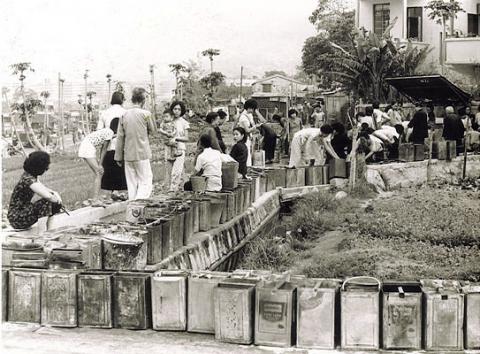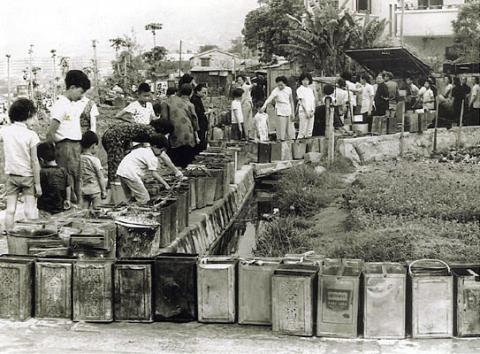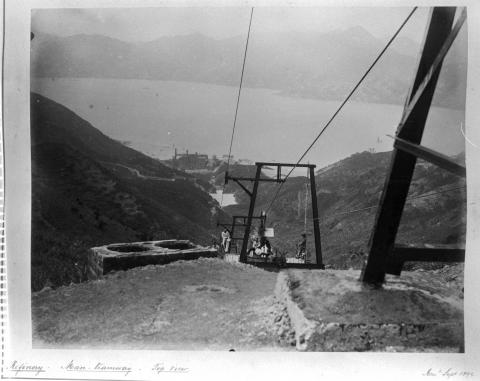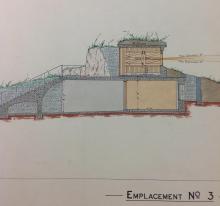Hot & thirsty: the struggle to supply Hong Kong with drinking water
Primary tabs
After an unusually hot month of May, I've been thinking about Hong Kong's drinking water. I've never had to worry about water rationing, so I take it for granted there's water in the tap. That's only a recent luxury though, as Hong Kong struggled for many years to provide its residents with enough drinking water. I'm sure many readers will remember scenes like this.
Catching the rain
Hong Kong doesn't have any large rivers or natural lakes it can rely on for fresh water, so early residents relied on gathering rainwater from local streams then later from wells. The next development was to build reservoirs to catch more of the rain before it ran to the sea, and store it until it was needed.
Here's a look at how Hong Kong's reservoir capacity grew over the years [1]:
| Year | Capacity (milion m3) |
| 1840-60 | 0.000 |
| 1870 | 0.009 |
| 1880 | 0.309 |
| 1890 | 1.728 |
| 1900 | 1.865 |
| 1910 | 4.463 |
| 1920 | 10.918 |
| 1930 | 11.596 |
| 1940 | 26.871 |
| 1950 | 26.871 |
| 1960 | 47.328 |
| 1970 | 242.466 |
| 1980 | 516.140 |
That's impressive, but of course the population [2] was growing at the same time. To see if the reservoirs kept up, let's see how much water storage capacity there was per person.
| Year | m3 per person |
Population (million) |
Capacity (million m3) |
| 1840-60 | 0.000 | ||
| 1870 | 0.1 | 0.122 | 0.009 |
| 1880 | 1.9 | 0.160 | 0.309 |
| 1890 | 7.8 | 0.221 | 1.728 |
| 1900 | 5.1 | 0.369 | 1.865 |
| 1910 | 9.8 | 0.457 | 4.463 |
| 1920 | 17.5 | 0.625 | 10.918 |
| 1930 | 13.8 | 0.840 | 11.596 |
| 1940 | 16.4 | 1.640 | 26.871 |
| 1950 | 14.4 | 1.860 | 26.871 |
| 1960 | 15.1 | 3.130 | 47.328 |
| 1970 | 61.6 | 3.937 | 242.466 |
| 1980 | 113.8 | 5.110 | 516.140 |
| 2017 | 78.5 | 7.410 | 516.140 |
Those figures are better than I expected. I thought we'd see much greater drops in the numbers along the way, but they stayed fairly steady from the 1920s to the 1960s then jump up in the 70s and 80s when the Plover Cove and High Island reservoirs were completed.
What do the numbers mean?
Or, what's a cubic metre of water like?
It's not very big - it would fit under your dinner table. It is heavy though, as it weighs 1,000Kg which is a metric ton.
If you're going to drink it, it's the same amount of water as 1,000 one-litre bottles. So looking at 1980, when there were 113.8 cubic metres of water storage per person, that means 113,800 litres of water per person. If you had that much water to use over a year, that would be around 300 litres a day.
Here's how the other years' figures translate into daily amounts of water.
| Year | litres per day |
m3 per person |
Population (million) |
Capacity (million m3) |
| 1840-60 | 0 | 0.000 | ||
| 1870 | < 1 | 0.1 | 0.122 | 0.009 |
| 1880 | 5 | 1.9 | 0.160 | 0.309 |
| 1890 | 21 | 7.8 | 0.221 | 1.728 |
| 1900 | 14 | 5.1 | 0.369 | 1.865 |
| 1910 | 27 | 9.8 | 0.457 | 4.463 |
| 1920 | 48 | 17.5 | 0.625 | 10.918 |
| 1930 | 38 | 13.8 | 0.840 | 11.596 |
| 1940 | 45 | 16.4 | 1.640 | 26.871 |
| 1950 | 40 | 14.4 | 1.860 | 26.871 |
| 1960 | 41 | 15.1 | 3.130 | 47.328 |
| 1970 | 169 | 61.6 | 3.937 | 242.466 |
| 1980 | 312 | 113.8 | 5.110 | 516.140 |
| 2017 | 215 | 78.5 | 7.410 | 516.140 |
How much is enough?
That 1980 figure sounds like a lot of water. Imagine opening the door each morning and finding that Park & Shop had delivered 300 litre bottles of water to your door. Would we use it all by the end of the day?
A WHO publication on how much water is needed in emergencies [3] estimates 15-20 litres per person per day is needed in a refugee camp. That covers basic drinking, cooking and hygiene. The table above shows Hong Kong was still struggling to meet that number into the 1910s, showing just how limited the water supply was initially.
Once you move on from those very basic requirements, the amount of water used tends to rise as a country becomes richer. People move from a daily wash with a cloth and bucket to two showers a day. Or a new washing machine means a daily clothes wash, instead of the old weekly trip to the nearest stream.
Another way to understand the figures is to compare them with the daily average consumption for a range of modern countries [4].
- Our figures for Hong Kong in the 1920s-60s show around 40-50 litres per day. That's what someone living in Kenya or Bangladesh uses today.
- In 1970 it jumped to 169 litres per day, similar to a modern-day usage in Peru or the Philippines.
- Finally, the peak figure of 312 litres a day in 1980 is close to the daily usage in Norway or Spain today.
It seems like a 1980 Hong Konger shouldn't have used more water than a 2018 Spaniard, so why was there still water rationing into the 1980s?
Unfortunately there are several reasons why that reservoir capacity of 312 litres a day doesn't mean there were 312 litres a day flowing out of the taps.
1) Just because you build it, doesn't mean you'll fill it
Looking at the last ten years [5], around 260 million m3 of rainwater flowed into the reservoirs each year, or roughly half the capacity of our reservoirs. So instead of holding enough water to give you 312 litres a day, you could only plan to receive 156 litres a day.
2) Changeable weather
Next, each year's rainfall is different. Over the last ten years [5], the wettest year was 2016, pouring 385 million m3 of water into our reservoirs. But in dry 2011 they only received 103 million m3. A dry year like that would have cut the 1980s daily water allowance down to 62 litres a day.
3) Water isn't just for drinking
Hong Kong's industries also need water.
In the early years, companies were expected to take care of finding their own water. The Aberdeen Paper Mill needed plenty of water, and was built near a valley where they could build their own reservoirs. Over on the north side of the island the Taikoo sugar refinery, and later the Taikoo dockyard, both relied on a series of reservoirs they'd built on the surrounding hillsides to provide their water. You can see one of their reservoirs in this photo at the refinery from above - the reservoir is the light-coloured area near the centre of the photo.
But by the 1980s those had all closed, and Hong Kong's industry relied on the public water supplies.
I haven't found figures showing how the water usage was split in 1980, but in 2003, domestic users consumed just over half of the drinking water [6]. So if we halve our dry 1980s year again, we're down to 30 litres a day per person, and it isn't hard to see why rationing was needed.
Why did rationing go away?
Hong Kong's population has increased by about half since 1980, and our per-capita water consumption has increased even faster, so why haven't we needed water rationing during the last thirty years?
Two saviours: The Dong river, and the Hong Kong toilet
In 2017/18, Hong Kong used a total of 1,269 cubic metres of water [8], supplied from from the following four sources.
| Source | Million m3 | % of total | |
| 1. | Rain water gathered in Hong Kong during the year |
303 | 24% |
| 2. | Fresh water drawn from our reservoirs |
27 | 2% |
| 3. | Fresh water pumped from the Dong river |
664 | 52% |
| 4. | Sea water | 276 | 22% |
Items 3 & 4 are the two big changes that let us avoid water rationing:
- Large, additional supplies of fresh water are delivered to Hong Kong by pipeline from the Dong river in Guangdong.
- We stretch our limited supply of drinking water by using sea water instead of fresh water to flush Hong Kong's toilets.
There were lots of numbers to wade through in this week's newsletter, so thank you if you've read this far. Are there any photos or memories of Hong Kong's water supplies that you can share with us in the comments below?
For my contribution, here's a letter from the new Hilton Hotel to a guest in July 1963. It proudly lets them know the Hilton had a supply of water from its own well, so guests could take a shower each day and avoid the once-in-four-days water rationing that the rest of the city faced.
References:
- Reservoir capacities were calculated from the Chronology in the book Water for a Barren Rock, by Ho Pui Yin
- Population figures come from The Population of Hong Kong and Wikipedia's Population of Hong Kong by year. I've used the closest year available, eg the figures from the 1901 census for 1900.
- World Health Organisation: How much water is needed in emergencies
- Average water use per day for countries around the world
- Local Yield: https://www.wsd.gov.hk/en/core-businesses/total-water-management-strateg...
- An overview of water supplies in Hong Kong
- HK Government book: Hong Kong 1981, a review of 1980
- Hong Kong: The Facts - Water Supplies







Comments
Was there really water rationing in the 1980s?
One reader wrote in to say they didn't remember any water rationing in the 1980s.
The Government's yearbook, Hong Kong 1983, A review of 1982, records the rationing in 1981/2 on page 166:
Water restrictions had been imposed in October 1981. On January 1, 1982, a 10-hours-a-day supply was being maintained which was eased on May 5 with the introduction of a 16-hours-a-day supply. The easing of restrictions and their ultimate lifting on June 1 was made possible by the heavy rainfall in April and May which resulted in a substantial rise in the quantity of water in storage. Full supplies were maintained to industry, and other essential users during water restrictions, and after restrictions were lifted a full supply was maintained for the remainder of the year.
The same article also mentions the contribution of the desalination plant to Hong Kong's water supply:
The Lok On Pai desalting plant, which had been reactivated during water restrictions as an additional resource to supplement supplies, produced some 182,000 cubic metres per day during its period of operation. With the improvement in the total water storage quantity, the desalter ceased operations on May 16 and reverted to a 'standby resource'.
There's more about the Lok On Pai desalting plant at https://gwulo.com/node/14509
The Good Old Days
With limited water supply every 4th day, bathtubs were filled up with water for drinking. A rub down was required to maintain hygeine.
Wasted water?
As anyone will be aware when their water supplies have been disrupted by construction work in the area. One of the problems when isolating water supplies to districts for water rationing purposes by closing water main’s valves under roads or wherever they were located, was that those tasked with the job would invariably re-open the valves much too fast, resulting in the incoming water scouring the insides of the pipes dislodging rust and whatever else was surviving inside them.
When supplies to homes were restored, up to 30 minutes or more could be spent running all the water tap outlets until relatively clear water reappeared. Tap filters and shower-head would also need cleaning or replacing. If this was going on all over the Hong Kong much more water would have been wasted than could have been saved if the supplies had just been left on.
Opening the mains water valves too fast into empty pipes could also result in “Water Hammer” bursting old or weak pipes and consequently causing disruption by flooding roads, wasting even more precious water.
Water Shortage
Greetings. The photo shows people using recycled oil and fuel containers. To keep up with the demand, one worker made galvanized containers in an alley near my home. When water rationing began, the column of neighbours in my flat arranged a user-schedule. This was essential as the water pressure at my level 3 would drop significantly when the tap at level 2 (multi-families) is being used. Considering we had only a two-hour window one day out of several, this has worked out well. As for the water we stored, much of that ended up not used, so it was wasted. We had no water meter then. Regards, Peter
Access to drinking water after the Japanese invasion
Harry Ching's diary entry for 24 December, 1941 https://gwulo.com/node/14455 describes having recourse to a neighbour's well after the Japanese had turned the water off. I wonder if there are any private wells still around - always useful in times of crisis.
Barbara Anslow's diary entry for 21-22 December also mentions the dilemma of dry taps, although it was apparently still possible to buy canisters of water in town, presumably at a price.
Thanks for the memories and
Thanks for the memories and the extra information. Several more photos have been uploaded showing the rationing: https://gwulo.com/taxonomy/term/12330/photos-gallery
1960s water shortage
I remember well the water shortages, although my view is that of a child. Most important to me ws that we were allowed to NOT wear our school unifroms to the Peak School. instead of thise starched white dresses that I used to step ino, I could wear ordinary clothes.
ALso I remember being bathed in a bucket , I stood in it and water was splashed around me. When we went on 'leave' that I got into endless trouble because I didnt flush the toilet...I was well trained to not flush it!
Private wells
I was surprised to discover, when the pump lifting water to our storage tanks at the top of our apartment block complex, built in the early 1960's, had to be replaced, that the water is drawn from a private well underneath it. However, it only provides water for the tank supplying the toilets. Our regular tap water comes from the mains.
1953-62 also a child and
1953-62 also a child and remembering the filling of containers and the bath a regular occurrence. We lived in the top flat of 3-storeys two-thirds up The Peak.
1960s water shortage
I remember it well. I lived on the Peak and we had water for four days once every four days.
Seawater vs fresh water for toilets
Sarah,
Most homes use seawater for flushing toilets in HK, yours was probably one of the exceptions. In California nowadays people don't flush after every use, you would fit right in without being reprimanded for wasting water.
Oh yes we do. Big drought is
Oh yes we do. Big drought is over for now. I too lived on the Peak from 1965 and remember filling the tub every four days.